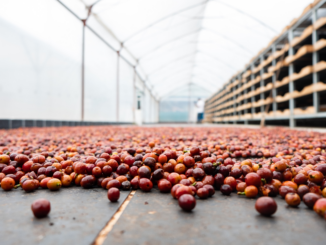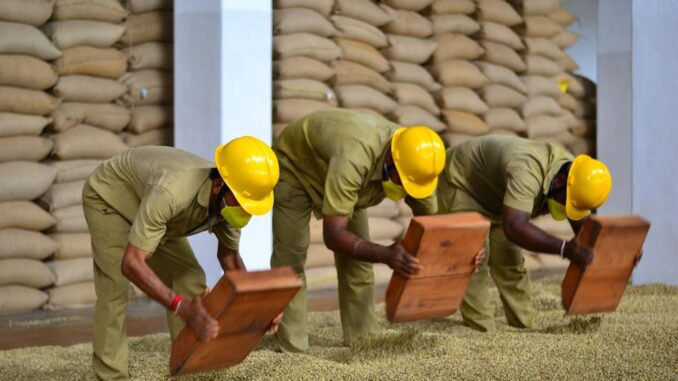
This processing method, which is unique to India, exposes coffee to moist monsoon winds.
BY TANYA NANETTI
SENIOR ONLINE CORRESPONDENT
Photos courtesy of Aspinwall & Co.
To be ready for roasting, a coffee must go through some kind of fermentation process, which will give it specific notes and often a typical flavor profile. Some fermentation techniques are considered “traditional,” such as natural, washed, and honey). In recent years, some other methods have become famous and widespread (anaerobic, double and triple fermented, and thermal shock, to name a few). While many of these fermentation methods are used worldwide, some are unique to a specific place, as is the case with the so-called Monsoon Process.
Melind John (he/him) is managing director and senior coffee bean hunter for Josuma Coffee, a U.S.-based green coffee importer that focuses exclusively on specialty coffee from India. Josuma was founded in 1992 and is still family-owned, with Melind being the second generation of the family running the business; today, he gives us a peek into this unique processing method.
“Coffee monsooning is a process unique to India,“ says Melind, “which dramatically alters many bean attributes: size, color, moisture, and cup characteristics.”
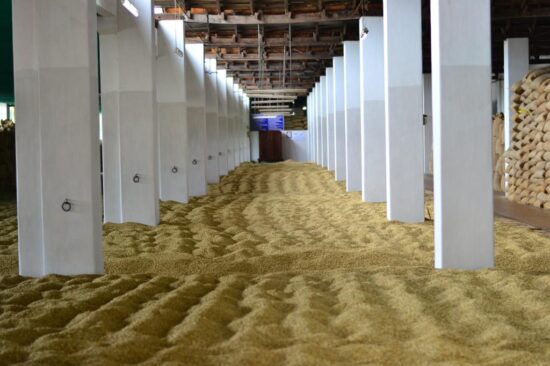
Rooted In History
In ancient times, wooden ships sailed to Europe with coffee from India and other tropical countries. During the four to six months required to complete this journey, the coffee was stored below the water line, in a humid atmosphere, because the wood was not airtight. As a result, the beans underwent a dramatic transformation over the course of the voyage. By the time the coffee reached Europe, the beans had changed color from green to pale gold and nearly doubled in size by gaining moisture. This change also led the coffee to almost completely lose its brightness and acidity.
As Melind explains, “Europeans loved—and still love—this coffee, but they weren’t fully aware of how unusual it was until steel container ships started transporting coffee. When this became the norm, the trip shortened, but the coffee stayed protected from the ocean environment, allowing it to reach Europe still dry and green, without losing its acidity. This is why India eventually developed the monsooning process, as a way to restore the flavor and low acidity Europeans were used to. This process, which is carried out on the west coast of India, attempts to use India’s annual monsoon season (which runs June through September) to replicate the conditions that coffee experienced when it traveled on wooden sailing ships.”
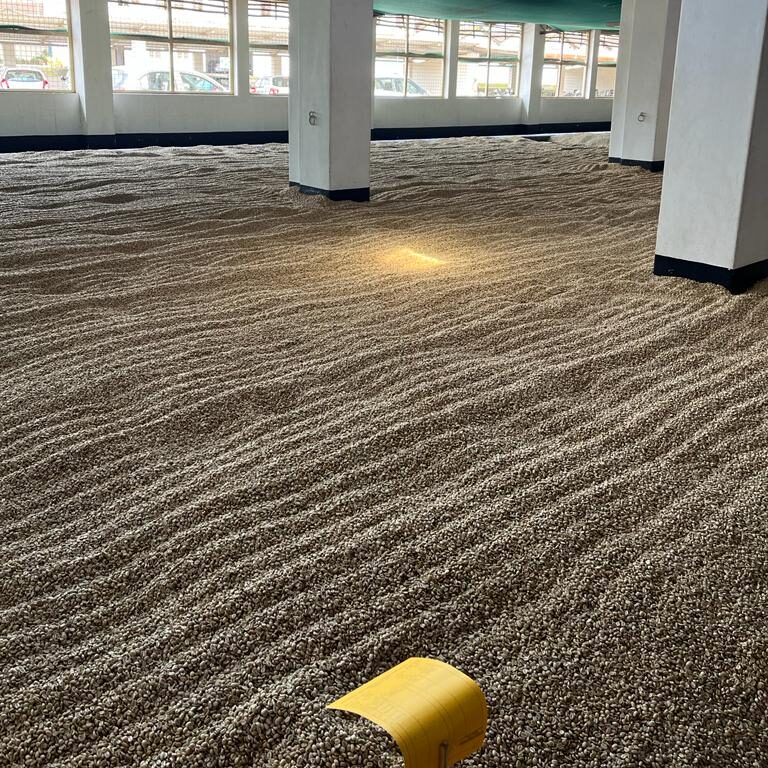
How It Works
“Monsooning exposes natural arabica coffee to the moist monsoon winds,” Melind explains. “This is achieved by placing the beans in ventilated warehouses that protect them from rainwater but not from the moist winds. The beans sit in layers four-to-six inches high and are raked frequently to equalize moisture absorption. This is followed by bulking and re-bagging at regular intervals. The total process takes 12 to 16 weeks.”
The monsooning process completely transforms the beans: By the end of it, several dramatic changes will have occurred. The beans will be swelled to almost double their original size, turning pale gold in color, with a high moisture content (close to 14.5% versus 10.5% for traditionally processed Indian coffees) but a much lower density than other coffees.
At the same time, monsoon processed coffee typically requires more roast development to preserve traditional coffee flavors and attributes. It tends to offer grassy/woody flavors when only lightly roasted. In the finished cup, the desired flavor notes are earthy with some combination of chocolate, nut, and sugar. Monsoon coffee tends to be full-bodied and has much lower acidity and brightness than other coffees.
Protected Status
“Monsooned coffee is technically aged coffee,“ Melind shares. “The beans that arrived in the U.S. in spring/summer 2022 were harvested as part of the 2020-21 harvest, so are already more than a year old according to the typical “fresh crop” or “current crop” clock. It’s also interesting to point out that monsooned coffee (particularly the “Monsooned Malabar” label, where “Malabar” is a geographic term referring to the southwestern coast of India, home of the largest monsooned production) has protected status under India’s Geographical Indications of Goods Act.”
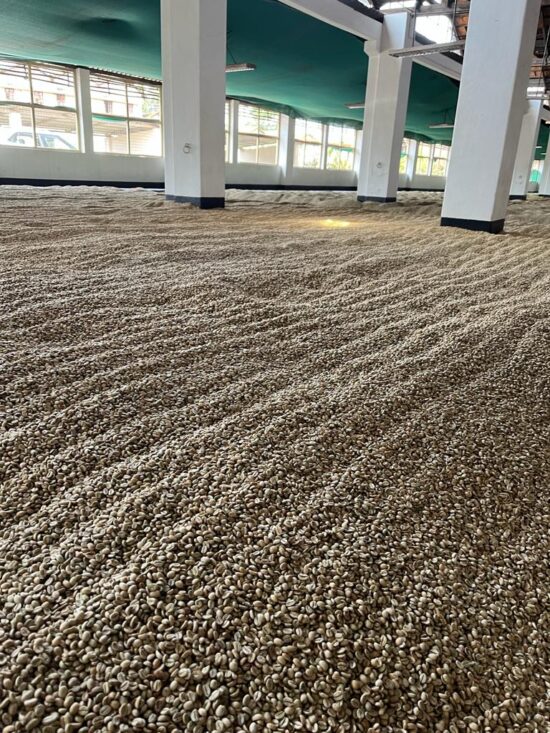
Process Pros and Cons
“Sadly, monsooned beans are off-trend for third-wave/farm-to-cup coffee,” Melind shares. “It’s rare to have farm-level traceability, as each container-size lot may be sourced from multiple farms. This happens because it’s really hard to monsoon at farm level, as a fair amount of space, structure, and labor is required. There is usually a larger entity (called a “monsooner”) that buys the dry-processed coffee from farms during the winter harvest and then subjects it to monsooning during the summer monsoon season. That said, having farm-level traceability may have limited value, as the monsooning process typically erases terroir: uniformity is often the goal with monsooning, with most monsooners aiming to minimize bag-to-bag (or year-to-year) flavor changes.”
It is worth mentioning that the monsoon process adds value to coffee at the source, instead of having value added only by importers/roasters in consuming countries. The cost of monsooning can usually be fully recovered by monsooners (along with a fair profit), unlike other more labor-intensive processing techniques that come with additional costs and challenges.
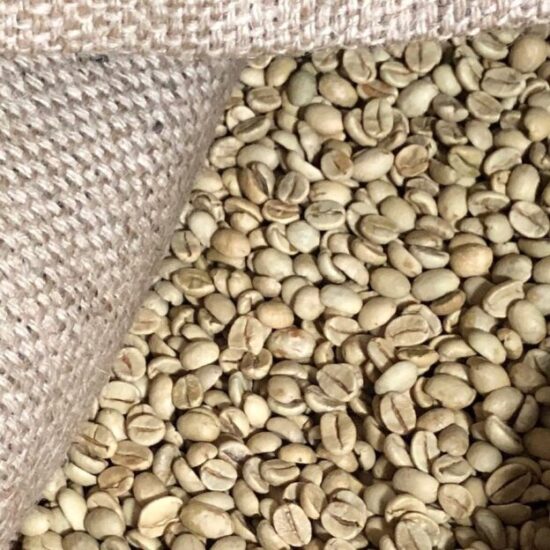
Compared to natural coffee, the monsoon process has a lower environmental impact because it doesn’t require additional water or create waste as a byproduct.
But the monsooning process has one downside: The changes caused by monsooning make the beans potentially challenging to roast.
Its density is far lower than other coffees; the moisture content is also an outlier. Roasting parameters that work for other coffees generally do not work well for monsooned beans. Significant adjustments are almost always required of roasters to get the desired attributes. However, if you are looking to roast something unique with a full body, low acidity, and sweet chocolatey, nutty notes, the results are well worth the effort.
ABOUT THE AUTHOR
Tanya Nanetti (she/her) is a specialty-coffee barista, a traveler, and a dreamer. When she’s not behind the coffee machine (or visiting some hidden corner of the world), she’s busy writing for Coffee Insurrection, a website about specialty coffee that she’s creating along with her boyfriend.



